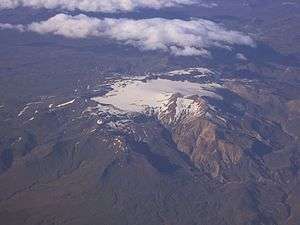Tindfjallajökull
Tindfjallajökull is a stratovolcano in the south of Iceland.[1] It has erupted rocks of basaltic to rhyolitic composition, and a 5-km-wide caldera was formed during the eruption of the 54,000-year-old Thórsmörk Ignimbrite. It is capped by a glacier of 19 km².[2] Its highest peak is Ýmir (1462m),[2][3] which takes its name from the giant Ýmir of Norse mythology. The most recent eruption was at an unknown time in the Holocene.[1]
| Tindfjallajökull | |
|---|---|
 Tindfjallajökull | |
| Highest point | |
| Elevation | 1,462 m (4,797 ft) |
| Coordinates | 63.8°N 19.58°W |
| Geography | |
| Location | Iceland |
| Parent range | Mid-Atlantic Ridge |
| Geology | |
| Mountain type | Stratovolcano |
| Last eruption | Possibly Holocene |
The name means "Tindfjöll glacier". Tindfjöll ("peak mountains") is a ridge that extends to the south of the glacier.
The rivers that flow from the glacier are Hvítmaga to the north-east, Gilsá to the south, Þórólfsá to the south-west, Valá to the north-west and Blesá to the north. Hvítmaga, Gilsá and Þórólfsá drain into Markarfljót while Valá and Blesá drain into Eystri Rangá.
See also
- List of volcanoes in Iceland
- Glaciers of Iceland
- Volcanism in Iceland
References
External links
- Tindfjallajökull in the Catalogue of Icelandic Volcanoes
- Map of the area
| Wikimedia Commons has media related to Tindfjallajökull. |